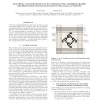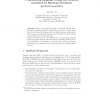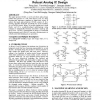89 search results - page 6 / 18 » Moore's Law is Unconstitutional |
MSE
2005
IEEE
2005
IEEE
Teaching Nanotechnology by Introducing Crossbar-Based Architecture and Quantum-Dot Cellular Automata
14 years 1 months ago
The end of photolithography as the driver for Moore’s Law is predicted within seven to twelve years and six different emerging technologies (mostly nanoscale) are expected to r...
SAS
2007
Springer
14 years 1 months ago
2007
Springer
Abstract. Silicon chip design has passed a threshold whereby exponentially increasing transistor density (Moore’s Law) no longer translates into increased processing power for si...
ETS
2006
IEEE
14 years 1 months ago
2006
IEEE
- The resources available on a chip continue to grow, following Moore's Law. However, the major process by which the benefits of Moore's Law accrue, which is the continui...
ICCD
2007
IEEE
14 years 4 months ago
2007
IEEE
Hybrid nanoelectronics are emerging as one viable option to sustain the Moore’s Law after the CMOS scaling limit is reached. One main design challenge in hybrid nanoelectronics ...
ICCAD
2008
IEEE
14 years 2 months ago
2008
IEEE
This paper presents ISCLEs, a novel and robust analog design method that promises to scale with Moore’s Law, by doing boosting-style importance sampling on digital-sized circuit...



